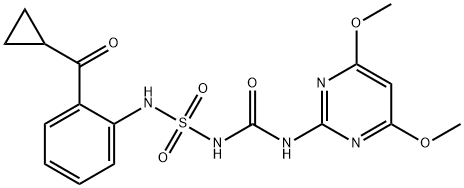Agricultural Uses
Cyclosulfamuron (AC 322140) herbicide was launched in 1997 by American Cyanamid and is marketed by BASF for control of a wide range of broadleaf weeds and sedge species in rice, wheat, and barley. Rice weeds controlled with greater 90% efficiency at an application rate of 45–60 g a.i. ha−1 include Cyperus serotinus, C. difformis, Elatine triandra, Eleocharis congesta, E. kuroguwai, Lindernia annua, L. procumbens, M. vaginalis, Rotala indica, Sagittaria pygmaea, S. trifolia, and Scirpus juncoides. Selectivity in the rice paddy is achieved due to various factors, including rapid metabolic degradation of the herbicide in rice shoots, placement of rice seedlings during transplanting, and the compound’s soil‐binding properties, which retain cyclosulfamuron in the upper soil layer of the paddy.
In rice, cyclosulfamuron is commercialized under the trade name “Ichiyonmaru” and “Saviour.” In combinations with daimuron and cafenstrole, it is sold as “Nebiros” and in combination with pentoxazone as “Utopia.” “Shakariki” is the trade name for the mixture with esprocarb. “Kanetsugu‐Radical” is a combination of cyclosulfamuron and pretilachlor that was recently introduced in Japan in 2015.
At application rates of 25–50 g a.i. ha−1, cyclosulfamuron can also be used in cereal crops for pre‐ and post‐emergent control of several important broadleaf weeds, such as Veronica persica, V. hederifolia, G. aparine, Matricaria spp., and P. convolvulus.
Cyclosulfamuron cannot be synthesized by any of the general methods depicted in Scheme 2.2.1. From the methods reported in the patent literature, Brady et al. describe a straightforward reaction of 2‐amino‐4,6‐dimethoxypyrimidine with chlorosulfonylisocyanate (CSI) at 0 °C with a mixture of 2‐aminophenyl cyclopropyl ketone and triethylamine to yield 70% of the desired herbicide. The synthesis of cyclosulfamuron and its intermediate products was also reported in 2005 by Tan et al.


